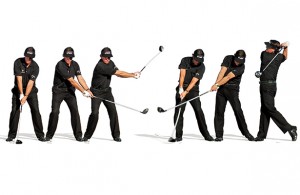Learning From One Of Golf’s Most Artistic Swings
Try as he might to inject technical excellence into his golf swing, Phil Mickelson remains a feel player at heart. Lefty’s driver swing is in many ways an extension of his magical execution with the wedges – long on imagination, inspiration and innovation, and short on textbook regimentation. But even though Mickelson’s driver swing strays from technical perfection, it exhibits traits definitely worth adopting. When Phil is playing well, his driver is a formidable weapon that has helped him win 42 US PGA Tour events, including five majors.
A massively long hitter for most of his career, Mickelson also has spells of great accuracy off the tee. And he’s a true shotmaker with the driver, drawing and fading the ball at will, shaping shots to fit any fairway. His driver swing is eye-catching and fun to watch, with athleticism from start to finish and amazing tempo and rhythm.
At age 44, Mickelson still swings with a reckless freedom that oozes confidence. After a career-long quest to make his technique more efficient and reliable, Phil has emerged with a swing that average golfers should admire. Below are a few moves to copy.
Setup and Takeaway: start tension free, then swing back wide
The keys to Phil’s setup and takeaway reflect his feel-oriented approach to the swing. His address is “plain vanilla”, with the grip neutral, ball inside the front heel, posture nice and tall, knees flexed. Nothing unique there.
The most outstanding feature of Phil’s setup is the obvious lack of strain in his arms and hands. Amateurs would do well to copy his tension-free setup. If you grip the club tighter than Phil is demonstrating, tension will creep up your arms and spread through your upper body. The result: a choppy, forced backswing devoid of rhythm and smooth tempo.
From a relaxed setup, Phil swings the club back wide, his arms extending well away from his upper body and the clubhead moving straight away from the target.
This is another great move to copy, because it creates a bigger swing arc and lengthens the backswing – keys to storing power for the downswing. Another lesson to be learned from the first part of Phil’s backswing is his quiet lower body.
Try to maintain flex in your rear leg, as Phil is doing here. And keep the heel of your front foot planted, unless your body rotation prompts it to come up naturally.
Finally, think of getting a full windup with your shoulders. For power, how much you turn is more important than how far back your arms swing.
Swinging Through: Make A Level Strike, And Stay In Balance
Phil has always been a power player, with his distance coming more from speed and athleticism than sheer muscular strength. As you approach the ball, try to swing your arms as fast as possible, allowing them to pass in front of your upper body. By the time you reach this stage of your swing, your weight should be almost fully shifted to your front side.
In Phil’s case, (and every good player’s) the weight shift occurs gracefully, not with a forward lunge.
Through impact, let the ball simply get in the way of the clubhead. Swing through rather than at the ball, with the clubhead travelling level well after the ball is gone.
Phil has talked frequently about trusting the loft of the clubface to get the ball airborne. There’s no need to help the ball up to send it on a nice, high trajectory.
Phil likes to hit the driver hard, and who doesn’t? For more distance, you should feel as if the clubhead is continuing to accelerate after the ball is on its way. Like Phil, allow both arms to straighten after impact, a sign of a full release. You want to sustain that wide arc you established on the takeaway. Then let the momentum of the swing carry you into a balanced finish.
Your weight should be firmly on your front side, your arms folded comfortably, and your belt buckle turned to the target.

PRO-FILE
Phil Mickelson
44 / 6-foot-3
California
Driver
Callaway Big Bertha Alpha, 8.5 degrees
Ball
Callaway SR 3
+
callaway glove
house of fleming belt

